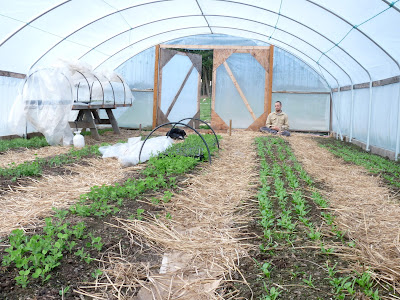After days of chipping away at my greenhouse, I am happy to report that it is now fully planted out in tomatoes! What an exciting end to a week of beautiful weather - the clear skies and long, sunny days made moving tables and hauling flats of plant starts quite enjoyable. While I was sad to lose the last of the spinach and and pea shoots, the arrival of a greenhouse of tomatoes means summer has really begun. Here are some pictures of the transformation...
goodbye, greenery.
tables put outside, spinach and peas pulled.
beds raked and broadforked. One bed here is covered with a light-reflective red plastic that Casey brought back from the Exchange. It's supposed to help with early fruit set, and at the very least will act as a weed barrier.
Serena arrives to help me put the first plants in the ground! Each start is soaked in a fish emulsion solution, then the bottom leaves are pruned off. The plants are placed on their sides in shallow holes, with most of the developed stalk buried sideways. Tomatoes produce what are called adventitious roots, meaning that fine hairs on the stem will turn into roots if buried underground. This results in an overall more vigorous root system. While at first the exposed plants may lean a little, a few days of sunlight have them growing straight and true.
Cherry tomatoes ready to go in the ground. Note boombox in the background playing French pop music. Tomatoes love French pop music.
Done!
I still have flats and flats of beautiful heirloom and thoughtfully-chosen hybrid tomato starts: Stupice, Legend, Sungold, Sweet Million, Black Cherry, Black, Black Krim, Druzba, Moonglow, Dagma's Perfection, Big Beef, Yellow Beefsteak, Red Brandywine, Taxi, Persimmon, Early Girl. Please contact me if you're interested in purchasing some!
In other news, our new farmhand arrived today from Austin, Texas. Sara Joy reported that she left HER tomato plants with nearly ripe fruit on the vines. So interesting to think that here I am on Orcas Island just waiting for my first harvest-worthy crop of radishes while folks down south are about to eat tomatoes, squash, and other hot crops that are still months away here. I'm looking forward to spending Fridays in the garden with Sara Joy and picking her brain about what else she's already eaten that I'm dreaming about.
Tomorrow represents the first time I will be at the farmer's market without produce to sell. I am thankful to have bountiful starts, meat, wool, and honey, but it is a blow to the ego to have an otherwise empty table. Another reminder of how far behind this season is from last year, when I had baskets brimming with salad greens, cilantro, kale, and radishes. I tilled and planted as soon as I could, so now all I can do is encourage the starts that are already in the ground. Oh well. In the meantime I will rub some lotion on my sunburned shoulders and continue to encourage my tomatoes with the French radio station they have grown to love.



































